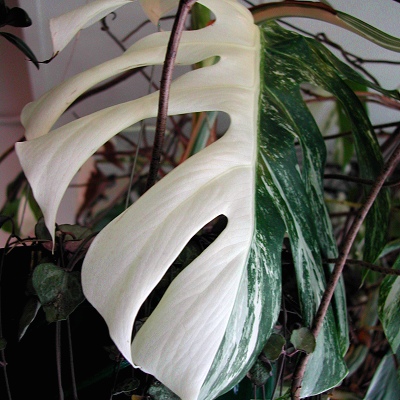Monstera deliciosa var. albo-variegata (Borsigiana) Caring for your plant
Pot size -- I recommend starting your plant in a 1 to 2 gallon pot (4-8 liters) for a few months before moving it to a larger container. Use a pot with drainage holes. A permanent home for a large, mature plant that is allowed to spread would be 10+ gallons (40+ liters), but if pruned shorter it may be kept in a smaller pot. Soil -- Like many Aroids, Monstera likes well-draining soil, preferably "chunky". Many different mixes can work, but a typical mix is 2 parts potting soil, 1 part small-grade orchid bark, and 1 part perlite. An alternate mix is 2 parts potting soil to 2 parts perlite (medium or large size, not small), or pumice. If you tend to overwater your plants, add extra perlite and/or orchid bark to your mix. Transplanting -- The plant may be hard to slide out, since the roots are adhesive and may glue themselves to the pot. First water the soil if it's dry and wait 20 minutes for it to thoroughly soak in. If the roots stick to the pot, try squeezing the sides and bottom of the container while gently pulling on the stem. If that doesn't work, you may need to cut the pot apart with scissors or a box cutter blade. Wear leather gloves if using a blade. After repotting, don't pack the soil down - simply water it. Watering -- Allow the soil to dry out halfway between waterings. Don't let it dry out completely, but also don't keep it constantly saturated. The amount of water to give depends on your situation, but if you're unsure if the soil is moist enough, use a moisture meter. Climate -- It can tolerate a wide range of temperatures, but it's happiest between about 65-85 degrees F (18-29°C). If it seems to suffer from low humidity indoors, consider using an ultrasonic room humidifier, sold at home improvement store and some thrift shop. Outdoors, temperatures above freezing are essential. Light -- It does best with bright light, but not much direct sun, unless it's weak sun. The leaves might burn if exposed to too much sun, so its best to filter it through a curtain, shade cloth, etc. Fertilizing -- It likes moderate amounts of fertilizer and does not need a lot of fertilizer to be happy. Feed about every 4 months with a general-purpose fertilizer that contains micronutrients. Follow the dosage on the package. If the older leaves turn yellow, it's often a sign that the soil has been too dry down in the root zone, which you can check with a moisture meter probe. If you're certain the roots have been moist enough, the plant may need more fertilizer, particularly nitrogen. Keep in mind that it's normal for the plant to occasionally shed an old leaf. Changing the leaf coloration -- The leaves can change their coloration over time depending on light levels, getting more white if exposed to very bright light, and more green if kept in low light. If the new leaves get too white, you can encourage more green coloration in future leaves by reducing the light intensity. Conversely, if the new leaves become too green, increasing the light intensity may encourage more white in future leaves. It may take 2 or 3 leaves for changes to appear, so be patient whenever trying to change the leaf color. Note that greening of the leaves may also occur in cool conditions, like on the floor of a cool room. In such cases, try raising the pot higher, where the air is warmer. The amount of green & white in a leaf is determined by the stem's coloration at the point where the leaf emerged. If your plant stays overly white or green despite changing the light intensity as mentioned above, you can try to encourage side shoots to develop, which may have better coloration. There are 2 methods for this, Keiki paste and pruning. First try Keiki paste, which is a hormone that encourages side shoots. Simply spread a thin layer on the axillary bud - the raised lump in this photo. If that doesn't work after a few weeks, you can try pruning back the stem by one or more nodes, which will encourage side shoots. Supporting your plant -- When it's larger, you can give it something to climb on for support, like a trellis, moss pole, wires, or a wall. As it grows, it holds on by using its long, dangling aerial roots, which adhere very strongly. They may damage surfaces if removed, so keep that in mind when choosing a spot for it. You may cut off the aerial roots if you wish. Pruning -- It can eventually grow 15+ feet vertically and horizontally if left unpruned, however you may cut it back to any size you wish. Side shoots will form after being pruned. Pests to watch for -- Look for any bugs that might affect your other houseplants. Try spraying with insecticidal soap first before using harsher chemicals. The main page for this plant is here. If you have questions, feel free to contact me. Enjoy your plant! - Jeff Strange Wonderful Things
|
|||||||||


